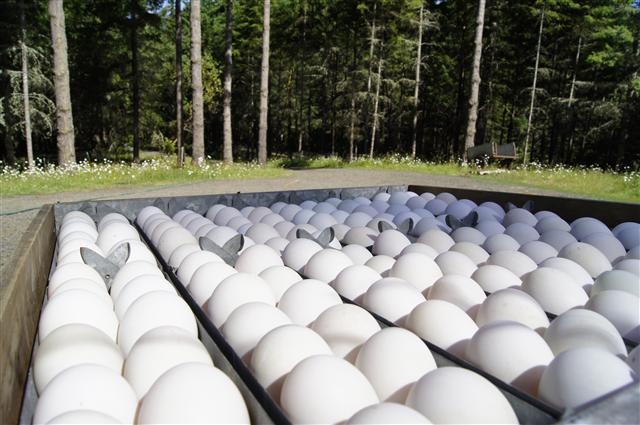OUR BREEDS
Why buy poultry if it's not the best?
We offer:
Ancona Ducks
Saxony Ducks
Delaware Chickens
1. PLEASE READ ORDERING INFORMATION
2. Place order on our ONLINE ORDER FORM .
3. We receive order and calculate shipping.
4. We will an email you an invoice.
5. Pay the invoice.
6. We ship you the ducklings, we will email or call before they ship.
-->REMEMBER ONLY THE SHIPPING MINIMUM IS 10, YOU CAN PICK UP ANY NUMBER ON THE FARM<--
*We do ship hatching eggs, indicate if you wish to purchase them on the form.
Boondockers Farm focus: Ancona and Saxony Ducks, Delaware Chickens
The original Holderread Ancona flock resides at Boondockers for genetic preservation. We correspond with Dave Holderread to ensure his breedingstandards are kept up with the Ancona flock. We have the most diverse population of Ancona ducks and the mostcolors available.
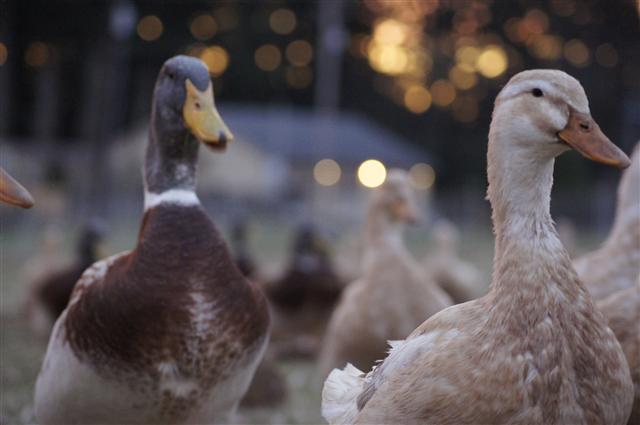 Since 2006 ducklings we have been obtainingstock from Holderread Waterfowl Conservancy and have been selected for egg laying and foraging ability and withshow quality standards. We also have purchasedstock fromCarol Deppe in 2009who has a wonderful small Anconaflock she also does genetic selection with for egg production.In 2010, Boondockers Farm acquired
all of Dave Holderread's Ancona stock to continue his 30+ years of
amazing work to produce the most productive Ancona ducks possible. We
arekeeping allof Dave's breeding traits intact. As with all rare
breeds, it is especially important to choose stock birds that are
vigorous, free of physical deformities and have classic breeds traits.
Since 2006 ducklings we have been obtainingstock from Holderread Waterfowl Conservancy and have been selected for egg laying and foraging ability and withshow quality standards. We also have purchasedstock fromCarol Deppe in 2009who has a wonderful small Anconaflock she also does genetic selection with for egg production.In 2010, Boondockers Farm acquired
all of Dave Holderread's Ancona stock to continue his 30+ years of
amazing work to produce the most productive Ancona ducks possible. We
arekeeping allof Dave's breeding traits intact. As with all rare
breeds, it is especially important to choose stock birds that are
vigorous, free of physical deformities and have classic breeds traits.
 The Ancona was developed in Great Britain during the early twentieth century and most likely originated from Runner ducks and Huttegen ducks, an old Belgian duck. This is the same foundation stock as the Magpie duck. They have been raised in the United States for several decades and were exhibited in 1983 in Oregon. Although still rare, their numbers have been increasing since 1984 when they first became available to the public. (Holderread)
The Ancona was developed in Great Britain during the early twentieth century and most likely originated from Runner ducks and Huttegen ducks, an old Belgian duck. This is the same foundation stock as the Magpie duck. They have been raised in the United States for several decades and were exhibited in 1983 in Oregon. Although still rare, their numbers have been increasing since 1984 when they first became available to the public. (Holderread)
The Ancona averages 6 to 6.5 pounds and is a bit stockier than its close relative, the Magpie duck. It has a medium sized oval head, a medium-length bill that is slightly concave along the top line, an average neck that arches forward slightly and body carriage is 20 to 30 degrees above horizontal. The broken, mottled plumage is unique among ducks for, like Holstein cattle, there is no set design. "Any combination of white and color is acceptable as long as there are obvious broken areas on the head, backs, sides, and underbody." The neck is normally solid white, bills are yellow with dark green or black spotting, and the legs and feet are orange with black or brown markings that increase with age. (Holderread) Varieties include Black and White, Blue and White, Chocolate and White, Silver and White, Lavender and White, and Tricolored. Chocolate is a sex-linked recessive trait. If a chocolate drake mates with a black duck, all female offspring will be chocolate, while all male offspring will be black. A black drake mated to a chocolate duck produces all black offspring. Only male offspring will carry the sex-linked recessive chocolate gene. (Holderread)
The Ancona is a hardy, adaptable, all-purpose duck. It is an excellent layer, typically laying 210-280 white, cream, or blue eggs yearly. The Ancona also grows relatively quickly, and produces high quality meat that is more flavorful and less fatty than that of most Pekin ducks. Anconas are well suited for situations where they can forage for some of their food and are capable of eating large "banana" slugs. They make excellent pond or yard ducks since they tend to stay close to home, do not fly under normal conditions and are large enough so that they are less likely to be preyed upon by winged predators. Typically they have moderately calm temperaments and make fine pets.(Holderread)
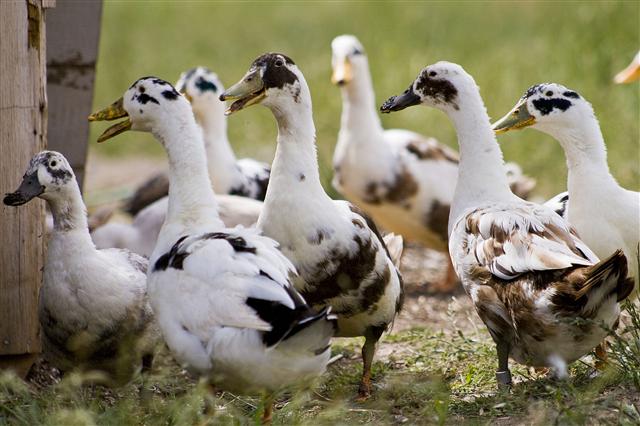
Since it is an excellent layer, productivity should be given a high priority in breeders. To produce the highest percentage of offspring with unique patterns, select birds with definite colored areas under their eyes and at least a bit of color in their chests. Avoid specimens that are either solid white or primarily colored with a white bib." (Holderread 2001, 53) While the Ancona is not yet recognized by the American Poultry Association, the ideal aesthetic is three quarters white plumage and one quarter non-symetricallycolored.
ALBC's 2000 census of domestic waterfowl in North America found only 128 breeding Ancona. While four people reported breeding Ancona, only one primary breeding flock with 50 or more breeding birds exists. (Bender, 4) There is a critical need for more conservation breeders of Ancona ducks. Their excellent laying ability, tasty meat, and calm dispositions make them a great addition to any small farmstead or backyard producer's flock.
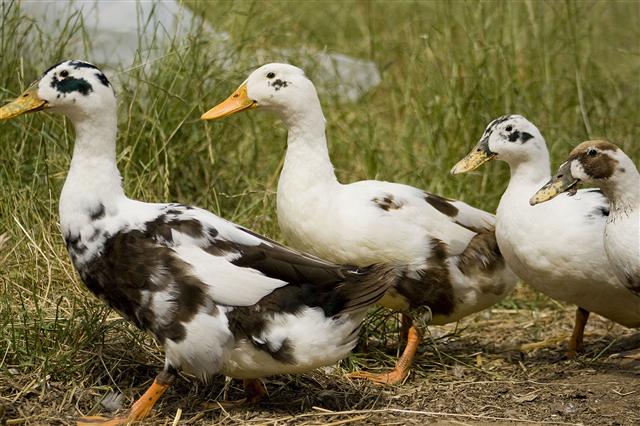 Uniquely to Anconas' the female is the one that goes to find forage, males of other species often keep their girls from finding precious food for their eggs. They are very active foragers making excellent garden pets that require minimum supplemental feed with adequate grazing area. They are very friendly, affectionate and will gladly sit with you if raised with proper handling.
Uniquely to Anconas' the female is the one that goes to find forage, males of other species often keep their girls from finding precious food for their eggs. They are very active foragers making excellent garden pets that require minimum supplemental feed with adequate grazing area. They are very friendly, affectionate and will gladly sit with you if raised with proper handling.
About ducks in general
- Ducks are notmeant to be on a 100% pasture but more with woodland/grassland type setting. We encourage them to use their built nests for their eggs which always doesn't seem to happen. We are experimenting with different methods and rotations currently to keep them out and let them lay only when they need.
- Ducks need to be locked away at night to protect them from predators of all kinds such as raccoons, skunks, wild and neighborhood dogs, unless you have a livestock guardian dog on full time duty.
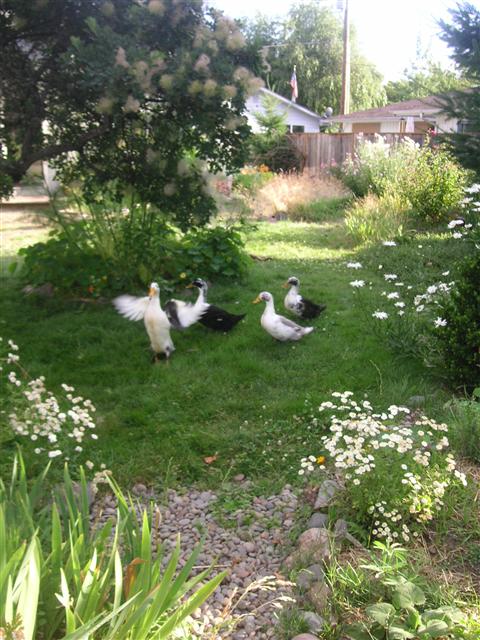
- Night time houses must be heavily constructed, have sturdy floors, be draft free but well ventilated. Any areas with chicken wire must be ¼ inch to prevent crafty raccoon arms from reaching in, remember these are strong animals with an appetite.
- For optimum protection we have brought two Great Pyrenees Guardian dogs to our farm to live with our ducks full time, you can read more about our livestock guardian dogs here. Now we have seven.
- Our ducks are supplemented with a nutritionally balanced custom organic feed with NO corn, and NO GMOs and NO animal products. They are supplemented with various vegetables from our garden, as well as dug up worms for an occasional treat.
- From the minute they hatch they are bonded with vocal encouragement and interaction. We believe that properly cared for and socialized ducklings make happier and easier going ducks. This and better understanding of your ducks needs and likes will translate to more consistent heavy egg production.
Incubation - More to come....We do all our incubation in 3 1940's Jamesway 252's.